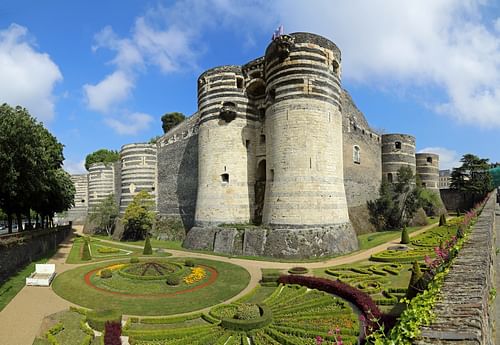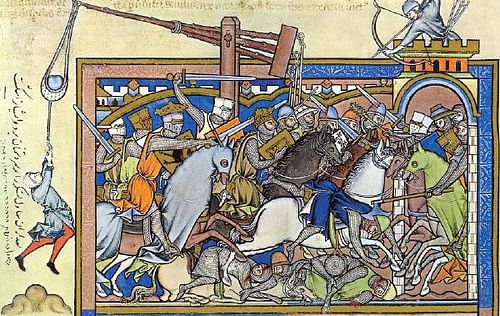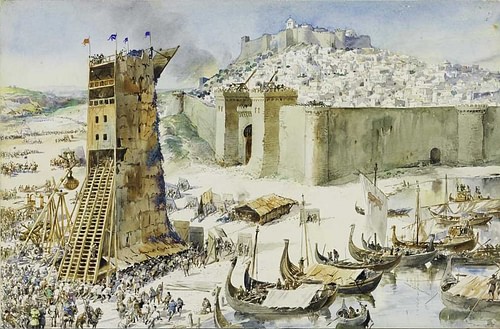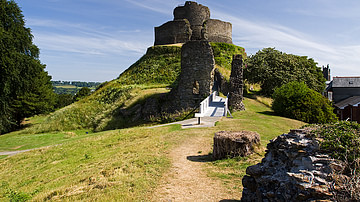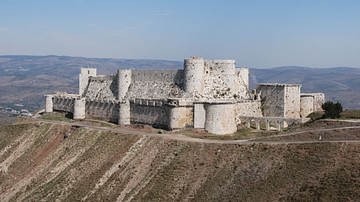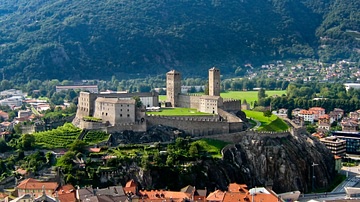Siege tactics were a crucial part of medieval warfare, especially from the 11th century CE when castles became more widespread in Europe and sieges outnumbered pitched battles. Castles and fortified cities offered protection to both the local population and armed forces and presented an array of defensive features which, in turn, led to innovations in weapons, siege engine technology, and strategies. From the 12th to 15th century CE medieval warfare became very much a case of win the siege, win the war, especially when targets were administrative centres or occupied a position of particular strategic importance.
Castle & City Defences
Early castles in France and Britain during the 11th century CE adopted the motte and bailey castle design. This involved placing a wooden tower on a natural or artificial mound (motte) with an accompanying walled courtyard (bailey) at the base with the whole structure surrounded by a ditch or moat (which could be dry or contain water). As these castles were gradually converted into stone, which made them much more resistant to fire, or entirely new castles were built and the idea of their usefulnees spread, so, too, their defensive designs improved.
The particular weak point of any defensive fortification was its main access door, but this came to be protected by a tower on either side with additional safety measures such as a drawbridge, portcullis and 'murder holes' (holes above the doorway through which missiles and burning liquid could be thrown down). The celebrated King's Gate of Caernarvon Castle in Wales had two drawbridges, six portcullises and five doors. The gate might also receive extra protection with a barbican - a short piece of fortified wall built in front of it. City gates were such substantial structures that many still stand today across Europe from York to Florence.
The outer walls of a castle (and sometimes even smaller cities) were protected by a moat (dry or wet) and wherever possible built on a rise in the land. In the Low Countries, where this was often not possible, the moat was made extremely wide. Walls were given towers at regular intervals to provide more scathing fire from archers, and the construction of wooden hoardings which overhung the top of the wall was for the same purpose. Further tweaks in design included having the towers project from the wall so that the defenders could fire back towards it if it were being climbed by the enemy. Eventually, it was discovered that round towers were better than square ones because they eliminated the firing blind spot of the corners and made them more stable and more difficult to dismantle from the base by enemy sappers or miners (who preferred easy corners to swing their picks at). Walls and towers were given a protective covering of stone at their bases (a talus) to impede the enemy climbing them, make undermining more difficult and give objects thrown down an unpredictable bounce into the enemy ranks.
To give another ring of protection, a second inner wall was added to castle designs from the late 12th century CE, especially in Britain, France, and Spain. With its own fortified gatehouse, it, in effect, doubled the difficulty of conquering the castle and, being higher than the outer wall, could be used to fire missiles over it or at it if breached. Even if attackers got past the two sets of walls, there was the final redoubt, the tower keep - a large tower with a small entrance on the first floor (i.e. above the ground floor) which was protected by its own forebuilding. By the late 14th century CE tower keeps went out of fashion and were largely replaced by greater towers set in the walls themselves, although in Spain and Germany, keeps continued to be popular with castle architects. The 13th-century CE Castle of Angers in France is a good example of an architect putting all his faith in round towers in the circuit wall.
Finally, there were the defenders themselves to contend with. Castles and fortified cities controlled the local countryside and so were usually the permanent home of a force of knights who might be mercenaries, militia, or serving a local lord on a rotation basis. These heavily armoured cavaliers might ride out at any time and attack the attackers, sometimes by surprise using a well-hidden postern gate as happened during Frederick II's siege of Parma in 1247-8 CE. Indeed, the very presence of such a force meant that an invader could not simply bypass and ignore a castle or city or he and his supply lines risked being attacked by them later in his campaign.
Safe behind the walls, there were archers and crossbowmen who could fire missiles through narrow window slits. The defenders also had catapults to hurl large boulders into the besiegers and damage their siege engines and own catapults. The Byzantines had their secret weapon of Greek Fire - a highly flammable liquid fired from a hose under pressure. Although this seems to have been largely limited to naval warfare, it is difficult to imagine it was never used in land warfare, and Richard I managed to get hold of the formula and use it to good effect when he returned from the Third Crusade (1189-1192 CE). When all the conventional weapons ran out, the defenders then resorted to whatever they could hurl down on the attackers such as burning oil, flaming logs, spikes, and rocks. 
Opening Attack
Faced with all of these ingenious defences, the attackers had to consider carefully how to best go about besieging a castle or city. The simplest method was to encircle the target, cutting off its supply of food and reinforcements, and then wait for thirst and starvation to drive the defenders to a surrender. Torching any surrounding farmland and villages was a wise move, too, just in case the defenders were able to smuggle in supplies. Naturally, with a large castle or a city, this could take several months to have its desired effect. The defenders probably had their own water supply, had stocked up on foodstuffs and in an emergency could always resort to drinking wine, beer, or even horse blood. Castles such as those in Wales built by Edward I (1272-1307 CE) were specifically situated by the sea so that they could be resupplied under siege unless the attackers had a naval force as well as a land army.
The defenders might even have secret tunnels which allowed some movement of people and goods to circumvent the besiegers camped outside. If an entire city needed to be attacked, then encirclement could be an impossibility given the size of the force needed to surround it completely. This did not stop some ambitious commanders, though, such as the attack on Antioch during the First Crusade (1095-1099 CE) when the attackers built their own castles to protect themselves from sorties from the city. Indeed, building a siege castle to attack another castle was not an uncommon strategy in the Middle Ages. A castle was sometimes erected right in front of a gate to block any movement while the rest of the invading army left to fight elsewhere. In most cases, it was certainly advisable to protect one's camp with a palisade and ditch as a minimum precaution.
The best result possible, of course, was that the defenders would surrender immediately. Sieges were expensive and troops might be on a fixed term of service (40 days in English armies, for example) so time was also a factor to consider. In addition, the campaign season was typically limited to spring and summer, and the longer the attackers remained cooped up in their own camp, the more prone they were to attack from a relief force, disease, or even starvation themselves from lack of supplies in a hostile territory. Still, the very size of the attacking army might help achieve a quick result or even the reputation of its commander if they appeared in person - Henry I of England (1100-1135 CE) and Joan of Arc (1412-1431 CE) are two leaders who famously had this effect on several occasions.

If the defenders remained resolute, then the first step was to communicate a warning via messengers. In the age of chivalry during the High Middle Ages (1000-1250 CE), non-combatant residents might be permitted to flee the scene, but this was not the case when fighting the Crusades, for example. If the terms of surrender were rejected, then that might be the opportunity to employ a few terror tactics. The lobbing of a few severed heads of messengers (even the messenger himself sometimes) or other captives over the defender's walls via catapult was a common tactic and reminded of the consequences of continuing the battle. Another strategy was to threaten to hang someone near and dear to the owner of the castle outside its walls - as happened when King Stephen threatened to hang Roger le Poer, whose mother held the castle of Devizes in 1139 CE.
Battering Rams
A more active approach than permanent encirclement was to try and destroy a particular part of the defensive walls. The gate had long been a weak spot, but as they became more fortified, gates actually became one of the strongest parts of a castle or city. Still, a door was a door, after all, and many attackers were tempted to try and use fire or a battering ram to break it down. Alternatively, a section of the wall might be targeted by the rammers.
Battering rams had not changed very much since antiquity and were typically made of a large log of wood with a sharpened metal cover at one end. The ram could be simply carried by a group of men or put on wheels or suspended from a frame so that it could swing towards its target with greater force. Protection from missiles was offered by housing the ram in a wood and iron roof. The defenders might try to overturn the ram by dangling chains, ropes, and hooks. Rams could be used against walls, but even more effective were huge drills turned by ropes. Another useful device was a beam with a hook at the end which could be used to prise down a raised drawbridge.
Artillery
Artillery machines had been in use since antiquity, and as warfare spread in the High Middle Ages so they returned to the fore in sieges, blending designs from ancient Rome and Greece with new ideas from the Byzantine Empire and the Arab world. One attack strategy was to pound the wall with huge boulders fired by catapults (or mangonels, which used the torsion of twisted ropes and were based on ancient designs) and trebuchets (which used a counterweight and were first seen in Italy in the 12th century CE). Both types had a single arm with a sling or bucket attached which could launch a large boulder towards the enemy weighing anything from 50 to 250 kilos. Flaming missiles which had been covered in pitch could set fire to the wooden buildings of a town or those within a castle's bailey. Some catapult missiles were containers made from wood, terracotta, or glass containing a flammable liquid such as animal fat, which were designed to be smashed on impact like Molotov cocktails. Another artillery device was the ballista, a very large crossbow, which fired thick wooden arrows or heavy iron bolts with great accuracy. Not much use at penetrating stone, it was used more by the defenders, as it had the advantage of being more compact than a catapult and so three could fit into a single floor of a tower.
More imaginative weapons included kites being used to float incendiaries over the walls which were then shot down. In the 15th century CE, there was even the use of sulphur gas to drive the defenders out of their retreat - Pope Alexander VI was accused of such tactics during the siege of Ostie in 1498 CE. Naturally, the defenders had their own versions of missiles and could hurl hot coals, torches, boiling water or heated sand onto the attackers below. In addition, they could protect their structures from fire by covering them in noncombustible material like clay, chalk, turf or vinegar.
The earliest depiction of gunpowder artillery is a 1326 CE English manuscript which shows a cannon on a wooden stand ready to fire a metal bolt. Such early firearms, sometimes known as bombards, were usually more lethal to the people firing them, such was the lack of knowledge and design know-how of the medieval period in this area. James II of Scotland, for example, was killed by an exploding cannon in the 1460 CE siege of Roxburgh. Small firearms weighing up to 15 kilos were used from the 14th century CE and fired small balls, bolts or lead pellets. Walls were thickened and heightened as a response to the arrival of cannons, and defenders could, of course, have their own, which saw windows altered accordingly in many fortifications. When in the 15th century CE batteries of huge cannons were being used which fired balls weighing over 100 kilos, the days of static siege warfare effectively came to an end.
Undermining
If the fortification walls looked particularly thick and imposing, then an alternative strategy to bashing them into rubble with missiles was to attack them from below. The simplest method was picking out the stones with tools, protection being offered to these sappers by wooden shields, walls, and covered corridors or trenches. Undermining was more sophisticated and involved excavating tunnels under fortifications and then setting fires in them so that the walls collapsed under their own weight. Naturally, this was not possible if the castle had been built on a solid rock foundation. Unfortunately for the attackers, the defenders could work on counter-mines, which intercepted those of the enemy, and they could then lay fires and smoke out the besiegers and/or deliberately collapse the tunnels. A famous episode of undermining was the attack on Rochester Castle in England in 1215 CE when a corner of the keep collapsed after the miners had set a huge fire in their tunnel using wood and pig fat.
Siege Towers
An all-out assault on a section of wall at some point involved good old-fashioned scaling ladders and siege towers. The enemy could be softened up by artillery, but hand-to-hand combat - bloody and chaotic - was almost inevitable. Siege towers allowed the attackers to get near a wall or tower and possibly scale it or, at least damage it. Built of wood and assembled on site, they had their own wheels so that they could be positioned against a wall using manpower or oxen. These huge structures, often given names like the cat or bear, must have had a tremendous psychological impact. First, though, a portion of the castle or city's moat had to be filled in or bridged over - sometimes using prefabricated folding bridges - and then the tower could be wheeled across to within touching distance of the walls. Refinements included a projecting lower platform which protected sappers while they dug at the wall, a suspended battering ram, or a cradle arm and box which could lower a number of men over the wall. The besiegers received covering fire from their own archers shielded by wooden screens (pavises) or large shields (mantlets) and their catapults so as to keep the defenders distracted.
As the towers were made higher than the defender's walls, archers within the tower could fire down on the walls, clearing them of the enemy before they climbed across the tower's own drawbridge. Towers at the siege of Lisbon in 1147 CE were over 24 metres (80 feet) high, for example. The defenders tried all they could to resist the towers, for example shooting fire arrows at them, but a tower might be covered in water-soaked animal skins or metal plates to resist such a strategy. Another method was to fill trenches in front of the wall with loose earth so that it would collapse when a tower approached and sometimes the defenders even built their own tower to better attack the other.
Subterfuge
Although chivalry was a highly regarded ideal, there are plenty of instances of trickery in medieval siege warfare. Forged letters might be sent to a castle's commander purporting to be from his sovereign and ordering him to surrender, for example. A small number of men might disguise themselves and get into the castle. Sometimes a prominent knight might talk his way into a castle or city which did not realise he had, in fact, switched sides. There were even cases of blatant abandonment of diplomatic procedure like shooting down a leader while he was discussing peace terms on the battlements. Chivalry was abandoned, too, if the fight dragged on, such as when Henry V had dead animals thrown into the wells of Rouen in France during his siege of 1418-19 CE. Catapults might launch manure and corpses in the hope of spreading disease amongst the enemy. Finally, spies were used in both camps to find out weak spots of the defence or when exactly the attackers were having dinner and so were vulnerable to a raiding party.
Aftermath
If a castle or city did fall, then it was common practice to sack, pillage, burn, rape, and murder. Acts of clemency towards defenders who had not surrendered when they had had the chance at the start of the proceedings were the exception, not the rule. Churches and members of religious orders were, though, expected to be left unharmed. Oddly enough, soldiers might be better treated than non-combatants as they were thought to have simply done their professional job. Even when a commander did wish to be lenient, such as William the Conqueror after the capture of Dover in 1066 CE, his own men often ignored his orders in the excitement. This was perhaps understandable as one of the main motivators for fighting was a share of the booty afterwards, and not all soldiers were prepared to wait for their commander to take his share first. Then, some slaughters were deliberate to send a strong message to the enemy during a wider war such as the massacre ordered by Edward III after the fall of Caen in 1346 CE. Naturally, if a castle was in a strategically important position it was advantageous for the new owners to maintain it to defend their own regime so many were repaired and reused, sometimes even defended against a counter-siege, when the whole process started over again with the roles reversed.

